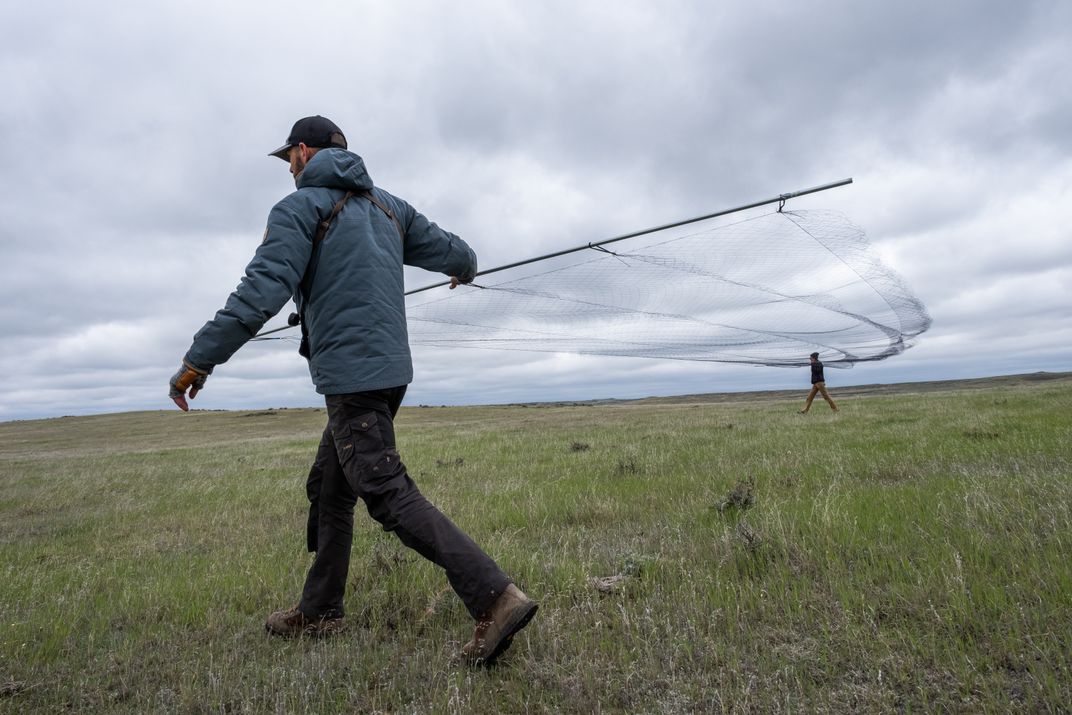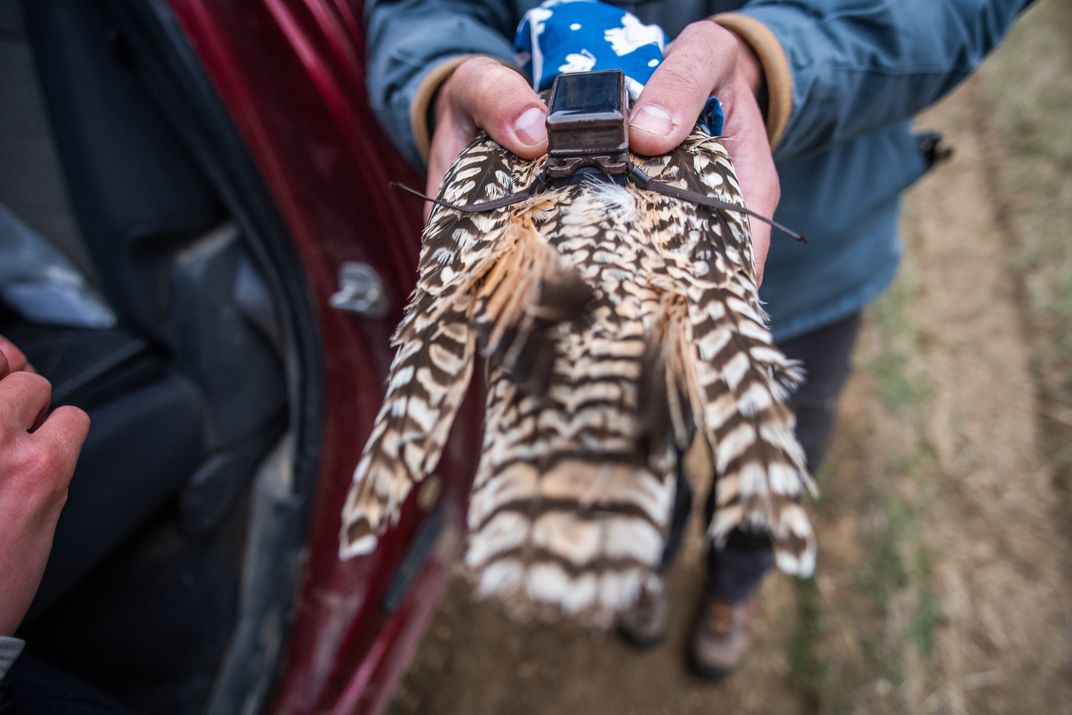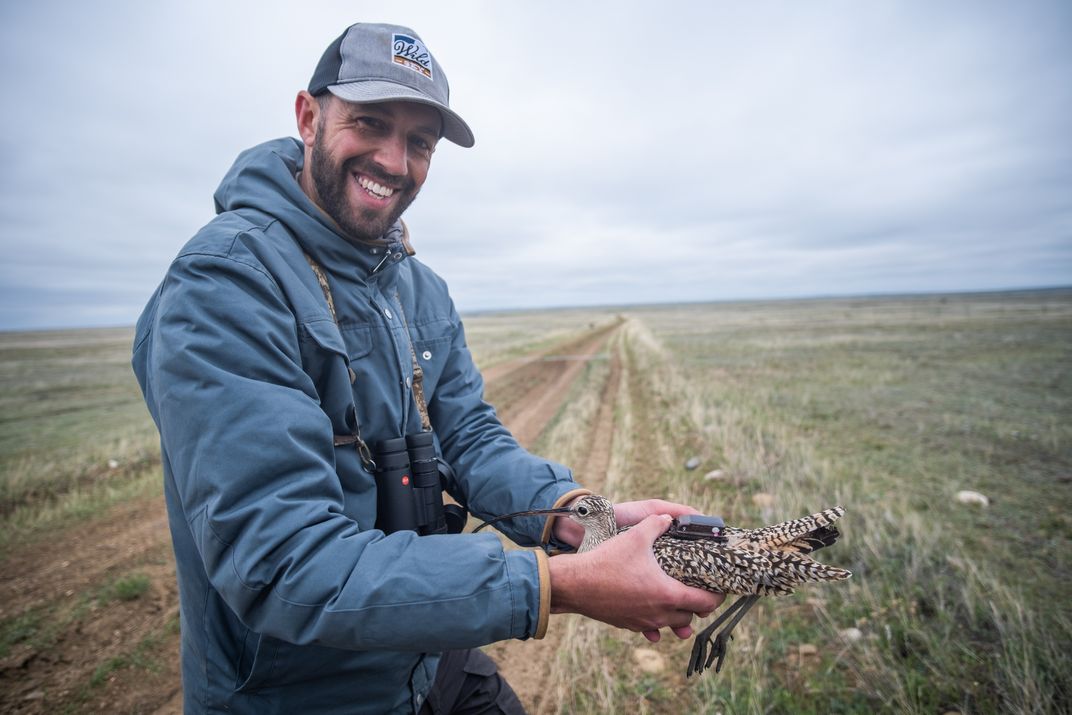NATIONAL ZOO AND CONSERVATION BIOLOGY INSTITUTE
Hiding in Plain Sight: Tracking the Long-billed Curlew
Long-billed curlew are shorebirds that spend their summers breeding in the grasslands of Montana. Smithsonian ecologists are equipping them with GPS trackers to learn more about their movements.
:focal(402x269:403x270)/https://tf-cmsv2-smithsonianmag-media.s3.amazonaws.com/blogging/featured/long-billed_curlew.jpg)
Standing on top of a glacier-smoothed knoll I can see a long way, but sight won’t help me now. The surrounding grasslands are a low-contrast palette of greens and browns, and my quarry matches them perfectly. So instead, I close my eyes and listen for the far-carrying whistles of the long-billed curlews. Better to build a map in my mind based on the birds' calls as they return from a quick bath in the creek, loudly fending off passing ravens or greeting their mates after a cold night apart. Once my map is built, I can get to work.
Long-billed curlews are the largest shorebirds in North America — about the size of a chicken, but with an impossibly long bill and infinitely more elegance. While curlews belong to a group called shorebirds, they are only found along coasts during the winter. They spend their summers breeding in the grasslands of Montana where we work.
Right now, conservationists have more questions than answers about these birds. So, we’re equipping them with GPS trackers to learn more about their movements.
Long-billed curlews nest in large, flat expanses of short-grass prairie. They are so confident in their mottled brown camouflage that you could walk right up to a nesting bird and it wouldn’t flee. So, in theory, catching one should be easy … but it’s not. Because first, we have to find the nests.
Curlews trust their camouflage for good reason. Adults are basically impossible to spot once they sit on their eggs. Incubating eggs is hard work. Curlew eggs are incubated 24 hours a day, so the male and female each take a 12-hour shift. Mom incubates during the day and dad at night. The only way to reliably find a nest is to catch the parents during a shift change. That means prime time for nest searching is when the female takes over at about 8 a.m. each morning.
But even this is tricky! We head out early searching for solo females. Finding a female on her own almost certainly means that her mate is sitting on the nest, and she will be heading there shortly to take over. So we watch intently and wait and watch some more. If all goes well, we’ll see a male curlew suddenly burst out of the grass beside the female. Then, the female will calmly and slowly settle onto the nest, instantly becoming invisible.
This is when the excitement really starts. Quickly, before we lose sight of the nest, everyone calls out identifying marks of the location. Sometimes “Just right of the rectangle shrub!” is as specific as you can get on the prairie. We train our scopes on the spot where the female has just disappeared, take a compass bearing and do our best to estimate the distance with a range-finder.
When a predator approaches, a curlew will stay still until the very last possible moment. Even so, we want to give the mother time to settle down on her nest. Thirty minutes tick by, and then it’s time to go. We unroll a 30-foot-long net as thin as spider silk and hold it taut between two of us. Then, we start the long march toward the nest. Back at the scope, a third person is guiding us toward our destination. Without them, we’d be flying completely blind.

With hand motions, they direct us left and right to make sure the net will be centered over the nest. Using our “rectangle shrub” as a landmark, we know we’re getting close. But where is the bird? The ground surrounding us is a greenish-brown carpet of native bunchgrasses, tiny prickly-pear and barrel cactus, and gravelly bare ground. No bird silhouette jumps out at us yet. A few more meters of marching, a pause and more desperate scanning.
Finally, the finely-barred, brown-on-brown feathers of a prone, completely still curlew mother come into focus. Celebratory expletives are uttered internally, and we move in unison to place the net over the bird. Startled, she jumps off the nest and gets caught in the net. We safely remove her and place a custom-made curlew mask over her eyes to keep her calm. Back at the truck, we secure the little GPS backpack to her using what ornithologists, or bird scientists, call a leg-loop harness (think of a climbing harness).

Once we’re positive that the harness is snug enough to stay on but loose enough not to restrict movement, we release the curlew back into her territory — angry, confused, but no worse for wear. Her little backpack is already at work. It records her position every 20 minutes with all the precision of a handheld GPS. Powered in perpetuity by a tiny solar cell, it can stay with her for the rest of her life.
We’ve already seen some of the data coming in from our long-billed curlews, and it is fascinating. The first big surprise is that these shorebirds hardly ever go to water while nesting. When females leave the nest to search for food, they typically head straight to an active prairie dog town.
Why is this their preferred feeding area? We don’t know yet. Perhaps the hundreds of rodent eyes constantly on watch provide an early predator warning system so the curlews can focus on feeding. Maybe the abundance of large insects that live in prairie dog burrows feeding on waste creates an irresistible buffet. This is just one question we hope to answer as the data continues to pour in.

I’m writing this in October, long after the curlews have headed south to their wintering grounds. We’ve just finished a field season, but I am already on edge waiting for April. When the birds come back north, they will be carrying a treasure trove of data. If we can locate them and download the data, we can fly (and walk) with these birds through their entire annual cycle.
We will be able to identify critical stops where curlews rest and refuel during migration. We can locate their wintering grounds and find out whether the same resources that are important during the summer also help get them through the winter.
Somewhere far to the south “our” curlews are going about their lives, hopefully oblivious to the tiny computers they carry along for the ride. I can’t wait to see them again in the spring to learn where they’ve been and what they’ve been up to. In the long run, this detailed travel log will serve as a roadmap for conservationists like me to help protect the habitats and resources that curlews need at every place they visit on their annual journeys.
The Smithsonian Conservation Biology Institute’s Center for Conservation Ecology collaborated with curlew experts Dr. Jay Carlisle and Stephanie Coates of the Intermountain Bird Observatory on this project.
Learn more about this project with additional videos, photos and blogs from the field.
